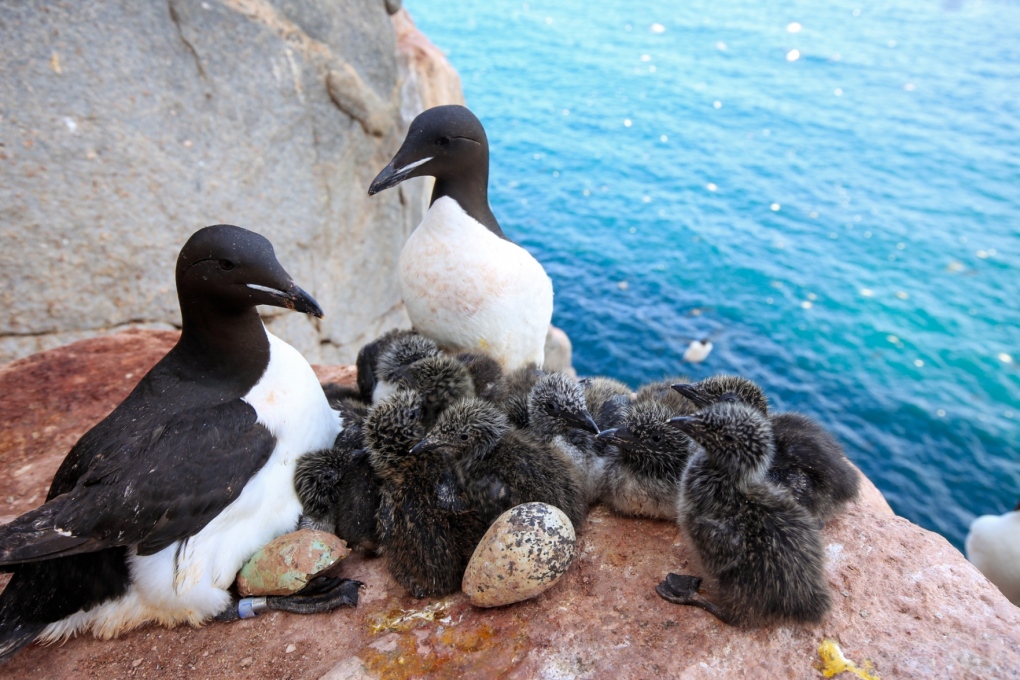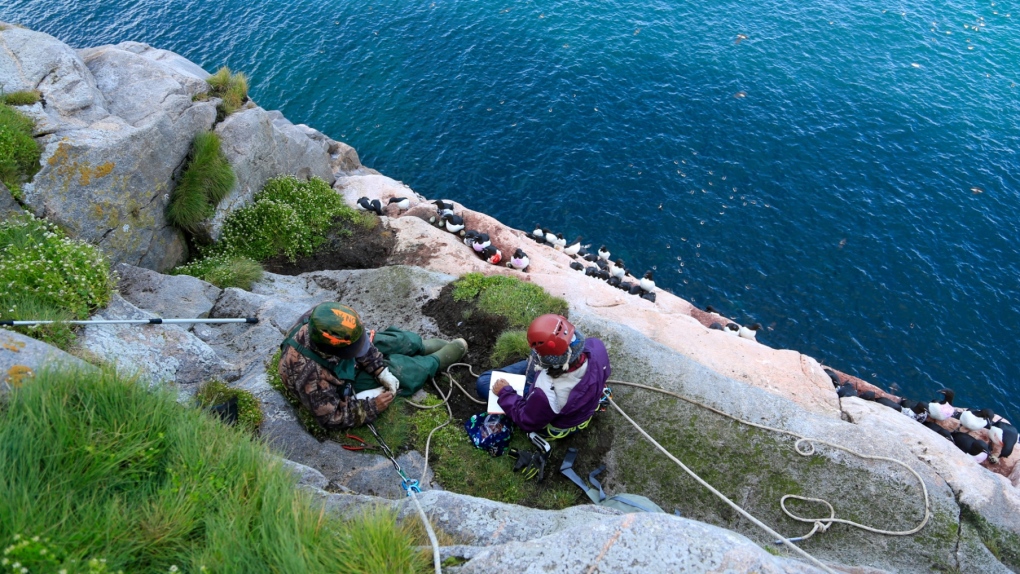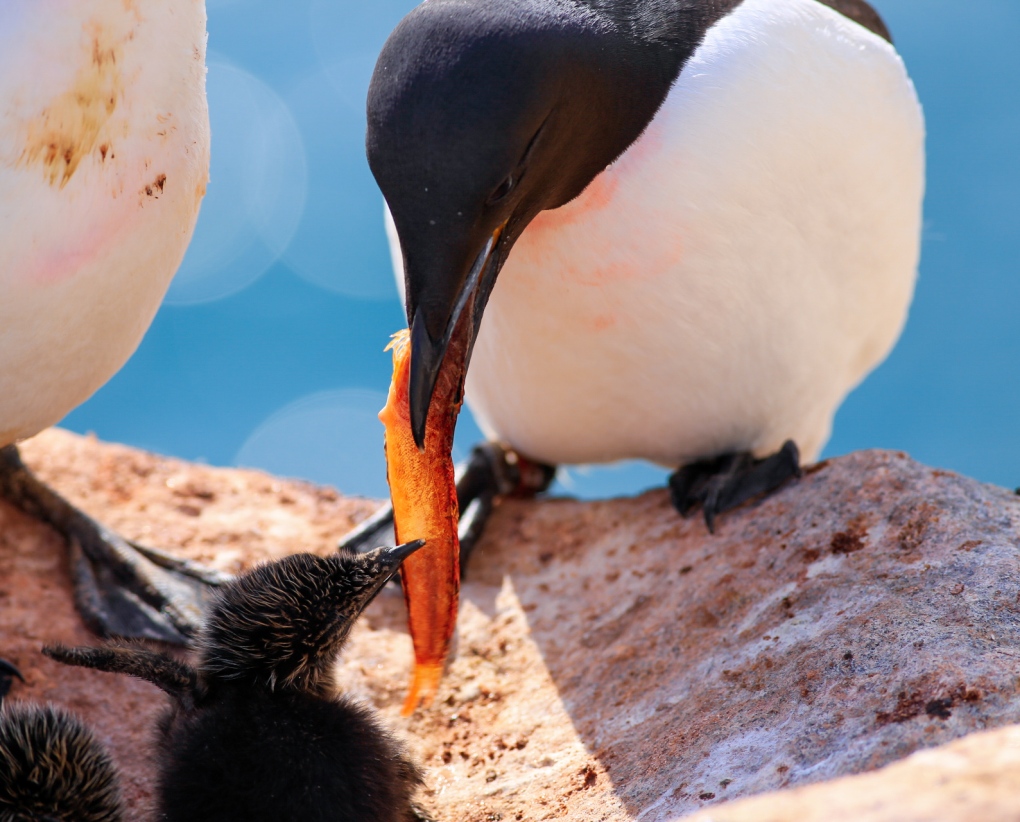Arctic seabirds have low tolerance to heat, McGill study suggests; what this means in a warming climate
 Two thick-billed murres watch over a group of chicks. (Douglas Noblet)
Two thick-billed murres watch over a group of chicks. (Douglas Noblet)
A jet-black head with eyes to match, a tuxedo of black and white plumage — at first glance, the thick-billed murre might be mistaken for a penguin. But this chicken-sized seabird is a creature of its own, inhabiting the seas, skies, and shores of the arctic.
Like so many northern creatures, however, the murre is threatened by rising temperatures and shortened winters — and a new McGill study is helping uncover why.
More formally known as Uria Iomvia, the thick-billed murre has adapted over time to the freezing cold, equipped with a high metabolism and a diet of fatty fish. But these adaptations may be backfiring as a result of rising temperatures, according to the study.
“Murres are [...] poorly adapted for coping with warming temperatures, which is important as the Arctic continues to warm,” says Dr. Emily Choy, a postdoctoral Fellow in the Natural Resource Sciences Department at McGill University and the study’s lead author.
To observe the effects of increasing temperatures on arctic seabirds, Dr. Choy and a team of researchers travelled to northern Hudson Bay, where they scaled the cliffs of Coats Island, living in close proximity to a colony of 30,000 thick-billed murres.
Through their research, the team uncovered an alarming reality: the thick-billed murre, so accustomed to a frigid climate, displayed signs of heat stress at temperatures as low as 21 degrees Celsius.
Although the thick-billed murre is not currently considered an endangered species, these findings point to a precarious future — especially considering that temperatures in the arctic are rising faster than anywhere else on earth.
 Two thick-billed murres watch over a group of chicks. (Douglas Noblet)
Two thick-billed murres watch over a group of chicks. (Douglas Noblet)
TURNING UP THE HEAT
To gauge the thick-billed murre’s heat tolerance, researchers used “flow-through respirometry,” a technique which involves placing the murre inside a chamber and measuring its oxygen levels. The chamber is gradually heated from the outside and the murre’s physiological response is recorded, after which the murre is returned to its nest.
“It’s a bit like hot yoga for birds,” says Dr. Choy. “We used respirometry to basically measure their breathing rate, the amount of oxygen they were consuming, but also their evaporative water loss, the amount of water they were losing.”
 Dr. Emily Choy (right) and a colleague take notes above a cliff-side colony of thick-billed murres. Researchers were required to take a rock-climbing course in preparation for the study. (Douglas Noblet)
Dr. Emily Choy (right) and a colleague take notes above a cliff-side colony of thick-billed murres. Researchers were required to take a rock-climbing course in preparation for the study. (Douglas Noblet)
Through this technique, researchers concluded that murres have very little tolerance to rising temperatures. This is likely linked to their high energy demands, says Dr. Choy.
“Although they can dive up to 200 metres in a matter of minutes, they also spend four hours a day flying. And in birds, diving and flying are an energetic trade-off, [and it’s] very difficult to do both,” she says.
To tackle this challenge, the thick-billed murre has developed a speedy metabolism, allowing it to burn more energy and produce high levels of body heat.
“When the climate starts to warm, this is a big disadvantage in terms of trying to cool down,” says Dr. Choy.
Cooling off is especially difficult for the largest of the murres, the research suggests, some of which weigh up to one kilogram.
“Body size is believed to be an adaptation [to] living in the cold — you lose heat less easily. But it seems like, in terms of heat, that backfires.”
PARENTING PROBLEMS
The female thick-billed murre produces one chick per breeding season, laying her egg on a cliff’s edge. There, she and her mate take turns nesting in day-long shifts. They rarely abandon their posts, even as temperatures spike.
“Murres have a very exposed nest, they nest in full sun,” explains Dr. Choy. “That makes them very vulnerable to heat.”
Over the years, thick-billed murres have been reported to overheat and die while nesting — and if one parent dies, the chick is unlikely to survive.
“Usually when one parent is incubating the nest, the other is foraging and bringing back food for the other parent or for the chick, so it’s nearly impossible to incubate and raise a chick with one parent.”
 A thick-billed murre feeds its hatchling. (Douglas Noblet)
A thick-billed murre feeds its hatchling. (Douglas Noblet)
To further complicate this issue, because thick-billed murres only lay one egg at a time, it may be difficult for the population to recover if it begins to dwindle.
“That’s why we have to be very careful in conserving the population and protecting them from stressors.”
A CANARY - OR MURRE - IN THE COAL MINE
With each passing decade, life on earth becomes hotter and hotter; just last month, an unprecedented heat wave took over parts of North America, with temperatures in Lytton, B.C. reaching a record-breaking 50 C. And while cold-adapted animals like the thick-billed murre are especially vulnerable to heat stress, they aren’t the only ones. With time, animals from warmer climates may be confronted with these issues too, says Choy.
“The arctic is considered an early-warning system for ecosystems in the south,” says Dr. Choy. “Thick-billed murres could be a canary in the coal mine [...] particularly in regards to the heatwaves birds have been experiencing in the pacific coast.”
“This is the first study to look at the impact of heat stress on arctic seabirds,” she adds. “I think what we’re finding is that heat stress is an understudied but important factor of climate change.”
CTVNews.ca Top Stories

Mark Carney reaches out to dozens of Liberal MPs ahead of potential leadership campaign
Mark Carney, the former Bank of Canada and Bank of England governor, is actively considering running in a potential Liberal party leadership race should Justin Trudeau resign, sources tell CTV News.
'I gave them a call, they didn't pick up': Canadian furniture store appears to have gone out of business
Canadian furniture company Wazo Furniture, which has locations in Toronto and Montreal, appears to have gone out of business. CTV News Toronto has been hearing from customers who were shocked to find out after paying in advance for orders over the past few months.
WATCH Woman critically injured in explosive Ottawa crash caught on camera
Dashcam footage sent to CTV News shows a vehicle travelling at a high rate of speed in the wrong direction before striking and damaging a hydro pole.
A year after his son overdosed, a Montreal father feels more prevention work is needed
New data shows opioid-related deaths and hospitalizations are down in Canada, but provincial data paints a different picture. In Quebec, drug related deaths jumped 30 per cent in the first half of 2024, according to the public health institute (INSPQ).
Much of Canada is under a weather alert this weekend: here's what to know
From snow, to high winds, to extreme cold, much of Canada is under a severe weather alert this weekend. Here's what to expect in your region.
Jimmy Carter's state funeral has started. Here's what to know
Six days of funeral observances for former President Jimmy Carter began Saturday in Georgia, where he died on Dec. 29 at the age of 100.
Jeff Baena, writer, director and husband of Aubrey Plaza, dead at 47
Jeff Baena, a writer and director whose credits include 'Life After Beth' and 'The Little Hours,' has died, according to the Los Angeles County Medical Examiner.
Hundreds of animals killed in Dallas shopping centre fire
A fire that broke out at a shopping center in Dallas on Friday morning killed more than 500 animals, most of which were small birds, authorities said.
MP Peter Fragiskatos calls on Trudeau to resign
Prime Minister Justin Trudeau has lost the confidence of another prominent Liberal MP.


































